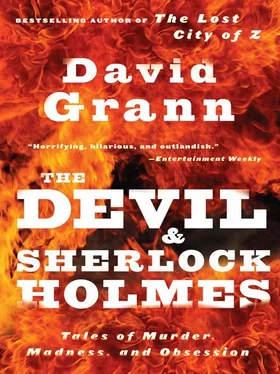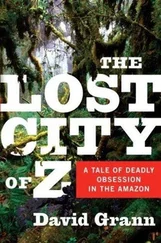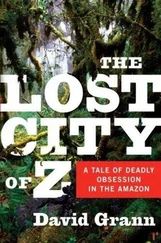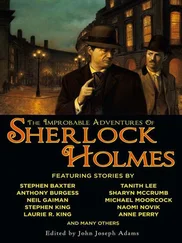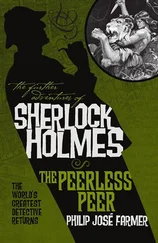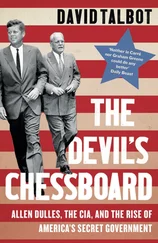David Grann - The Devil & Sherlock Holmes
Здесь есть возможность читать онлайн «David Grann - The Devil & Sherlock Holmes» весь текст электронной книги совершенно бесплатно (целиком полную версию без сокращений). В некоторых случаях можно слушать аудио, скачать через торрент в формате fb2 и присутствует краткое содержание. Жанр: Старинная литература, на английском языке. Описание произведения, (предисловие) а так же отзывы посетителей доступны на портале библиотеки ЛибКат.
- Название:The Devil & Sherlock Holmes
- Автор:
- Жанр:
- Год:неизвестен
- ISBN:нет данных
- Рейтинг книги:3 / 5. Голосов: 1
-
Избранное:Добавить в избранное
- Отзывы:
-
Ваша оценка:
- 60
- 1
- 2
- 3
- 4
- 5
The Devil & Sherlock Holmes: краткое содержание, описание и аннотация
Предлагаем к чтению аннотацию, описание, краткое содержание или предисловие (зависит от того, что написал сам автор книги «The Devil & Sherlock Holmes»). Если вы не нашли необходимую информацию о книге — напишите в комментариях, мы постараемся отыскать её.
comes this brilliant collection of true stories about people whose fixations propel them into unfathomable and often deadly circumstances.
Whether David Grann is investigating a mysterious murder, tracking a chameleon-like con artist, or hunting an elusive giant squid, he has proven to be one of the most gifted reporters and storytellers of his generation. In
, Grann takes the reader around the world, revealing a gallery of rogues and heroes who show that truth is indeed stranger than fiction.
The Devil & Sherlock Holmes — читать онлайн бесплатно полную книгу (весь текст) целиком
Ниже представлен текст книги, разбитый по страницам. Система сохранения места последней прочитанной страницы, позволяет с удобством читать онлайн бесплатно книгу «The Devil & Sherlock Holmes», без необходимости каждый раз заново искать на чём Вы остановились. Поставьте закладку, и сможете в любой момент перейти на страницу, на которой закончили чтение.
Интервал:
Закладка:
By the mid-nineties, Bourdin had accumulated a criminal record for lying to police and magistrates, and Interpol and other authorities were increasingly on the lookout for him. His activities were also garnering media attention. In 1995, the producers of a popular French television show called “Everything Is Possible” invited him on the program. As Bourdin appeared onstage, looking pale and prepubescent, the host teasingly asked the audience, “What’s this boy’s name? Michael, Jürgen, Kevin, or Pedro? What’s his real age—thirteen, fourteen, fifteen?” Pressed about his motivations, Bourdin again insisted that all he wanted was love and a family. It was the same rationale he always gave, and, as a result, he was the rare impostor who elicited sympathy as well as anger from those he had duped. (His mother has a less charitable interpretation of her son’s stated motive: “He wants to justify what he has become.”)
The producers of “Everything Is Possible” were so affected by his story that they offered him a job in the station’s newsroom, but he soon ran off to create more “interior fictions,” as one of the producers later told a reporter. At times, Bourdin’s deceptions were viewed in existential terms. One of his devotees in France created a Web site that celebrated his shape-shifting, hailing him as an “actor of life and an apostle of a new philosophy of human identity.”
One day when I was visiting Bourdin, he described how he transformed himself into a child. Like the impostors he had seen in films such as “Catch Me If You Can,” he tried to elevate his criminality into an “art.” First, he said, he conceived of a child whom he wanted to play. Then he gradually mapped out the character’s biography, from his heritage to his family to his tics. “The key is actually not lying about everything,” Bourdin said. “Otherwise, you’ll just mix things up.” He said that he adhered to maxims such as “Keep it simple” and “A good liar uses the truth.” In choosing a name, he preferred one that carried a deep association in his memory, like Cassis. “The one thing you better not forget is your name,” he said.
He compared what he did to being a spy: you changed superficial details while keeping your core intact. This approach not only made it easier to convince people; it allowed him to protect a part of his self, to hold on to some moral center. “I know I can be cruel, but I don’t want to become a monster,” he said.
Once he had imagined a character, he fashioned a commensurate appearance—meticulously shaving his face, plucking his eyebrows, using hair-removal creams. He often put on baggy pants and a shirt with long sleeves that swallowed his wrists, emphasizing his smallness. Peering in a mirror, he asked himself if others would see what he wanted them to see. “The worst thing you can do is deceive yourself,” he said.
When he honed an identity, it was crucial to find some element of the character that he shared—a technique employed by many actors. “People always say to me, ‘Why don’t you become an actor?’ ” he told me. “I think I would be a very good actor, like Arnold Schwarzenegger or Sylvester Stallone. But I don’t want to play somebody. I want to be somebody.”
In order to help ease his character into the real world, he fostered the illusion among local authorities that his character actually existed. As he had done in Orthez, he would call a hot line and claim to have seen the character in a perilous situation. The authorities were less likely to grill a child who appeared to be in distress. If someone noticed that Bourdin looked oddly mature, however, he did not object. “A teen-ager wants to look older,” he said. “I treat it like a compliment.”
Though he emphasized his cunning, he acknowledged what any con man knows but rarely admits: it is not that hard to fool people. People have basic expectations of others’ behavior and are rarely on guard for someone to subvert them. By playing on some primal need—vanity, greed, loneliness—men like Bourdin make their mark further suspend disbelief. As a result, most cons are filled with logical inconsistencies, even absurdities, which seem humiliatingly obvious after the fact. Bourdin, who generally tapped into a mark’s sense of goodness rather than into some darker urge, says, “Nobody expects a seemingly vulnerable child to be lying.”
In October, 1997, Bourdin told me, he was at a youth home in Linares, Spain. A child-welfare judge who was handling his case had given him twenty-four hours to prove that he was a teen-ager; otherwise, she would take his fingerprints, which were on file with Interpol. Bourdin knew that, as an adult with a criminal record, he would likely face prison. He had already tried to run away once and was caught, and the staff was keeping an eye on his whereabouts. And so he did something that both stretched the bounds of credulity and threatened to transform him into the kind of “monster” that he had insisted he never wanted to become. Rather than invent an identity, he stole one. He assumed the persona of a missing sixteen-year-old boy from Texas. Bourdin, now twenty-three, not only had to convince the authorities that he was an American child; he had to convince the missing boy’s family.
According to Bourdin, the plan came to him in the middle of the night: if he could fool the judge into thinking that he was an American, he might be let go. He asked permission to use the telephone in the shelter’s office and called the National Center for Missing and Exploited Children, in Alexandria, Virginia, trolling for a real identity. Speaking in English, which he had picked up during his travels, he claimed that his name was Jonathan Durean and that he was a director of the Linares shelter. He said that a frightened child had turned up who would not disclose his identity but who spoke English with an American accent. Bourdin offered a description of the boy that matched himself—short, slight, prominent chin, brown hair, a gap between his teeth—and asked if the center had anyone similar in its database. After searching, Bourdin recalls, a woman at the center said that the boy might be Nicholas Barclay, who had been reported missing in San Antonio on June 13, 1994, at the age of thirteen. Barclay was last seen, according to his file, wearing “a white T-shirt, purple pants, black tennis shoes and carrying a pink backpack.”
Adopting a skeptical tone, Bourdin says, he asked if the center could send any more information that it had regarding Barclay. The woman said that she would mail overnight Barclay’s missing-person flyer and immediately fax a copy as well. After giving her the fax number in the office he was borrowing, Bourdin says, he hung up and waited. Peeking out the door, he looked to see if anyone was coming. The hallway was dark and quiet, but he could hear footsteps. At last, a copy of the flyer emerged from the fax machine. The printout was so faint that most of it was illegible. Still, the photograph’s resemblance to him did not seem that far off. “I can do this,” Bourdin recalls thinking. He quickly called back the center, he says, and told the woman, “I have some good news. Nicholas Barclay is standing right beside me.”
Elated, she gave him the number of the officer in the San Antonio Police Department who was in charge of the investigation. This time pretending to be a Spanish policeman, Bourdin says, he phoned the officer and, mentioning details about Nicholas that he had learned from the woman at the center—such as the pink backpack—declared that the missing child had been found. The officer said that he would contact the F.B.I. and the U.S. Embassy in Madrid. Bourdin had not fully contemplated what he was about to unleash.
The next day at the Linares shelter, Bourdin intercepted a package from the National Center for Missing and Exploited Children addressed to Jonathan Durean. He ripped open the envelope. Inside was a clean copy of Nicholas Barclay’s missing-person flyer. It showed a color photograph of a small, fair-skinned boy with blue eyes and brown hair so light that it appeared almost blond. The flyer listed several identifying features, including a cross tattooed between Barclay’s right index finger and thumb. Bourdin stared at the picture and said to himself, “I’m dead.” Not only did Bourdin not have the same tattoo; his eyes and hair were dark brown. In haste, he burned the flyer in the shelter’s courtyard, then went into the bathroom and bleached his hair. Finally, he had a friend, using a needle and ink from a pen, give him a makeshift tattoo resembling Barclay’s.
Читать дальшеИнтервал:
Закладка:
Похожие книги на «The Devil & Sherlock Holmes»
Представляем Вашему вниманию похожие книги на «The Devil & Sherlock Holmes» списком для выбора. Мы отобрали схожую по названию и смыслу литературу в надежде предоставить читателям больше вариантов отыскать новые, интересные, ещё непрочитанные произведения.
Обсуждение, отзывы о книге «The Devil & Sherlock Holmes» и просто собственные мнения читателей. Оставьте ваши комментарии, напишите, что Вы думаете о произведении, его смысле или главных героях. Укажите что конкретно понравилось, а что нет, и почему Вы так считаете.
